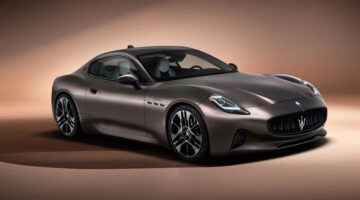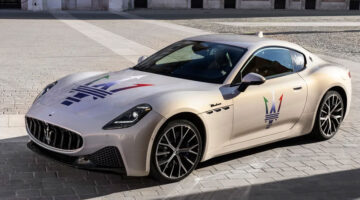In 2004, the world welcomed the Maserati MC12. A formidable V12, stunning design and a GT Championship dominance made people sit up fast.
[Not a valid template]It’s not often we get to celebrate the tenth anniversary of a motoring legend. Debuting in 2004, it didn’t take long for the Ford GT to sent shockwaves through the automotive world, and not simply because it was ferociously powerful. It had looks, it had character, and it had a heritage most manufacturers would sink to their knees and weep for. Ten years later, it would even appear in a crankandpiston.com video.
“But hang on”, says long-time crankandpiston mate Fast Auto, “the Ford GT wasn’t the only exclusive bruiser with a mid-mounted 630+ horsepower unit that made its debut in 2004”, a statement backed up by the awesome pictures that followed shortly after. And he’s absolutely right. Whilst one model was born with racing heritage already established, the other had only just started its own. One was a Ferrari 430-baiting bruiser fresh off the streets of Detroit, while the other – the Italian Stallion – was joined at the hip with Ferrari’s Enzo supercar. In 2004, the automotive fraternity welcomed not only the Ford GT but also the Maserati MC12.
Despite it sharing the same platform as its Ferrari Enzo bedfellow, there was little else the two models shared. Dimensionally, the MC12 – in deference to both the Maserati Corse motoring pedigree and the dirty great 650hp 6.0-litre naturally aspirated V12 belted down under the bodywork – was longer, taller and wider than its Maranello-based ‘counterpart’, and even lost out in the top speed top trumps battle, 330kph to the Enzo’s 350kph. Despite it’s beefier frame though, the MCC Maserati Corse Competizione (as it was called during development) boasted a few tricks up its blue and white sleeves. The first was F430, MP4-12C and Quattroporte designer Frank Stephenson.

Heading up the Ferrari Maserati Group’s Concept Design and Development department in the early 2000s, Stephenson’s team put a stress-bearing chassis made from carbon fibre, inlet channels down the flanks, meticulously carved air intakes and dual-fin carbon rear wing to the easel to significantly reduce drag and make the MC12 as aerodynamically slick as possible. Coupled with independent wishbone front and rear suspension incorporating anti-squat, anti-dive and anti pretty much everything for inch-perfect precision through the corners, and bolstered by its lightweight carbon fibre bodywork, the two-seater made up through the corners was it possibly lacked at the top end. You need only ask Mr Davison for his opinion on this subject following his shotgun passenger ride in a Corsa variant late last year.
The other arguably more salient reason was the MC12’s initial bout of success on the FIA GT Championship circuit, on which it made a three-race debut in 2004. Solid running in the latter half of the 2004 season saw the Trident secure two wins and seventh in the championship on its first official outing in an international series for 37 years. A bit of off-season tweaking, a revised driver line-up and two customer teams running with manufacturer support meant that in 2005, the MC12 obliterated its competition, scoring almost double the points of nearest rival Ferrari, 239 to 125. Between 2005 and 2010, the Trident took six team championships on the bounce and twice won the manufacturer’s crown. An unbelievable run given that, in 2004, the lack of a homologated model for the MC12 meant the Maserati was not awarded points and was even threatened with expulsion from the series. A road-legal model prepared ahead of the 2005 season set a dominant run in motion.

The homologated tendency of most road cars often makes for mixed reviews, and in 2005, the MC12 was no different. Optional luxuries like upholstery, leather trim and a clock saw the GT’s 1200kg base weight pork out a little to 1335kg, and the 0-100kph time increase from 3.6 to 3.8 seconds.
Maserati though wasn’t about to let all of its hard work be unravelled, hence why prospective owners will find no floor mats, no radio, an exposed rollover bar, painted bulkheads, and no decipherable storage space. Long weekends away in the MC12 are rather dependant on spare clothes can be folded into the footwells or stapled to the rear wing. Even the blue and white livery – in deference to the American Camoradi Scuedria racing colours once adorned by Sir Stirling Moss on his Maserati Tipo 60 – stayed put. To all intents as purposes, the MC12 really was a GT car for the road.
Its raw nature then proved only some people’s cup of tea, despite the sheer insanity and exclusivity of the model making it no less popular. The sheer power of the 630hp V12 meant kilometres were snapped in half as they flew past the Perspex windows, road testers internationally recommending that an orthopaedic surgeon on speed dial wouldn’t be the worst idea. Plus, though the Maserati Cambiocorsa six-speed gearbox was a tried, tested and oft-used unit, such was the ferocity of the acceleration that many wondered which would crack first: the transmission or the speedometer needle. Throw in a $1.6million price tag for one of only 50 made available to the public, and an everyday driver the two-seater certainly was not, removable hardtop or otherwise.

Maserati’s first road legal GT since 1982 then had made a big impression: what better way to remind fans and the automotive world of the marque’s presence than with decimating speed, stunning looks and a sportscar record few had seen since the Mercedes-Sauber days. Of course ten years down the line, with only 50 examples up for grabs – including the only black-painted example in the world that recently went up for sale in California – the MC12 remains a recluse, rolled out only for special occasions to frighten the neighbours and remind the world just what Ferrari’s baby sister could do when it gets the hammer down.
But Fast Auto has a point. Italian lunatic or not, a tenth anniversary is always worth celebrating. Especially when you’re lucky enough to find one parked outside your front door.
– Shots courtesy of Fast-Auto.fr
| Maserati | MC12 |
|---|---|
| Engine: | V12 / 5998cc |
| Power: | 630hp @ 7500rpm |
| Torque: | 481lb-ft @ 5500rpm |
| Transmission: | longitudinal rear-mounted gearbox rigidly connected to engine / Maserati Cambiocorsa mechanical gearbox with electronically controlled electro-hydraulic operation via paddles mounted behind the steering wheel / dry twin-plate clutch diameter 215 mm with flexible couplings and hydraulic control / Bosch ASR traction control / rear-wheel drive |
| Front suspension: | Double wishbones with push-rod design progressive-rate steel dampers and coaxial coils and springs |
| Rear suspension: | Double wishbones with push-rod design progressive-rate steel dampers and coaxial coils and springs |
| Brakes: | Brembo braking system / brake pad material Pagid RS 4.2.1. / Bosch 5.3 ABS anti-blocking system / electronically controlled braking corrector (EBD) / six-piston callipers cross-drilled ventilating discs 380mm x 34mm (front) / four-piston callipers with differentiated diameters cross-drilled ventilating discs 335mm x 32mm (rear) |
| Wheels: | front 9J x 19 (front) / 13J x 19 (rear) / light alloy |
| Tyres: | 245/35 ZR 19 (front) / 345/35 ZR 19 (rear) |
| Weight (dry) | 1335kg |
| 0-100kph: | 3.8 sec |
| Top speed: | 330kph |



